Use our hub pages as a reference to get up-to-speed on all the main digital marketing techniques. They will help you quickly understand how to make the most of the technique through definitions and recommendations on our member resources and blog articles covering strategy, best practices and the latest statistics.
We believe that an integrated digital marketing strategy is essential for marketers working in all types of business to take advantage of the growing digital marketing opportunities for acquiring and retaining customers - so you can win more sales.
In this article, we will explain how to structure a digital marketing strategy using the Smart Insights RACE framework using different examples.
The complexity of digital marketing is a key reason why a defined digital marketing strategy is needed, particularly by medium to large businesses. Our visual gives a B2B example of the complexity of customer touchpoints on the path to purchase that need to be part of a plan. If you're not prioritizing investments in these 'always-on' marketing activities, it's likely that your competitors are and are more effective in generating online leads and sales...
This is a B2B example of the always-on lifecycle marketing activities which are important to success. If you're new to the key tactic of 'always-on', read this article to learn about why it's important and see some B2C examples.
Still not convinced every larger business needs a digital strategy? Read our article on 10 reasons you need a digital marketing strategy for the compelling reasons why you need a dedicated strategy to prioritize your investments in digital communications.
But first, it's useful to define the scope of digital marketing since although digital marketing channels are important, digital strategy involves a lot more than this.
Most definitions of digital marketing strategy, dive straight into the digital marketing tactics like organic and paid search and social media (it's still vital to invest sufficiently in these channels and follow best practices).
For us, what is most important is how the strategy supports the business goals, how SMART objectives are set and how it is integrated with other offline marketing activities.
In his book Digital Marketing: Strategy, Implementation and Practice, our co-founder Dr. Dave Chaffey defines Digital Marketing simply as:
"Achieving marketing objectives through applying digital media, data and technology".
In our view, a Digital Marketing Strategy is essential to provide a consistent direction for online marketing activities and channel integration.
The aim of the strategy should be to ensure the integration of digital and other marketing activities and to support overall business objectives.
Digital marketing strategy needs to align with marketing strategies to grow a business through customer acquisition and retention, or to achieve the communications goals of not-for-profit organizations.
A digital strategy should also aim to impact business and marketing strategy by identifying opportunities to create value for customers and the business by reviewing new digital business and revenue models such as subscription commerce. It should also prioritize investments of people and media budget into key channels identified from the lifecycle visual and simplified below.
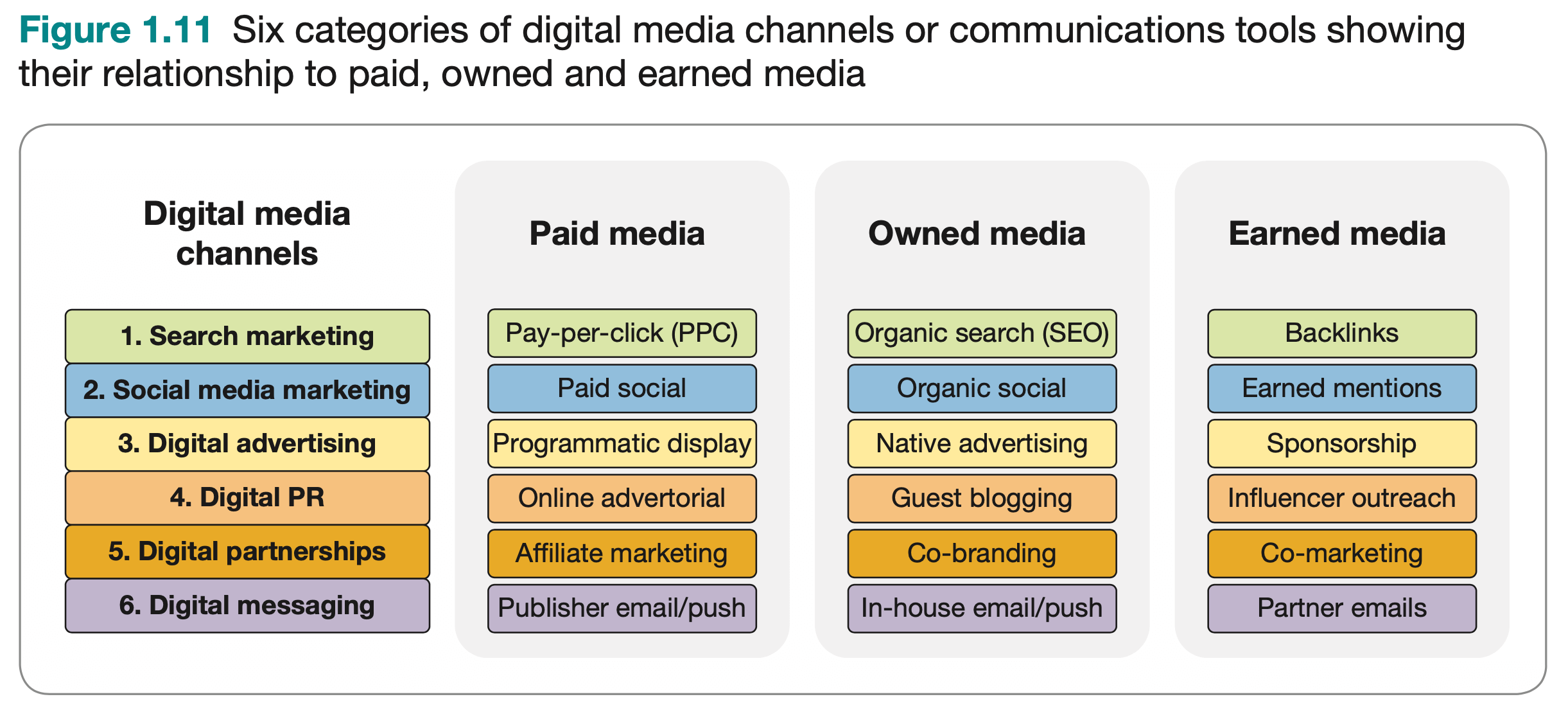
Dave created this diagram summarizing the six key digital media channels to simplify the many paid, owned and earned media options available on different platform such as Meta, Google, Microsoft, Amazon and publisher sites into six tactics for improvement, both for your marketing campaigns and continuous, always-on promotion. If you're learning about the differences between digital marketing channels, read our article What is digital marketing? for a simple explainer and video.
Based on the visual above, you're probably thinking, which of the channels in Figure 1.11 should I focus on? Good question. Of course it depends on the business sector, but search marketing is particularly important to prioritize on when there is a high search intent, i.e. people are searching for your products and services. Where this isn't the case social media, PR and display advertising are more important. This insight shows which digital acquisition channels are important across different sectors.
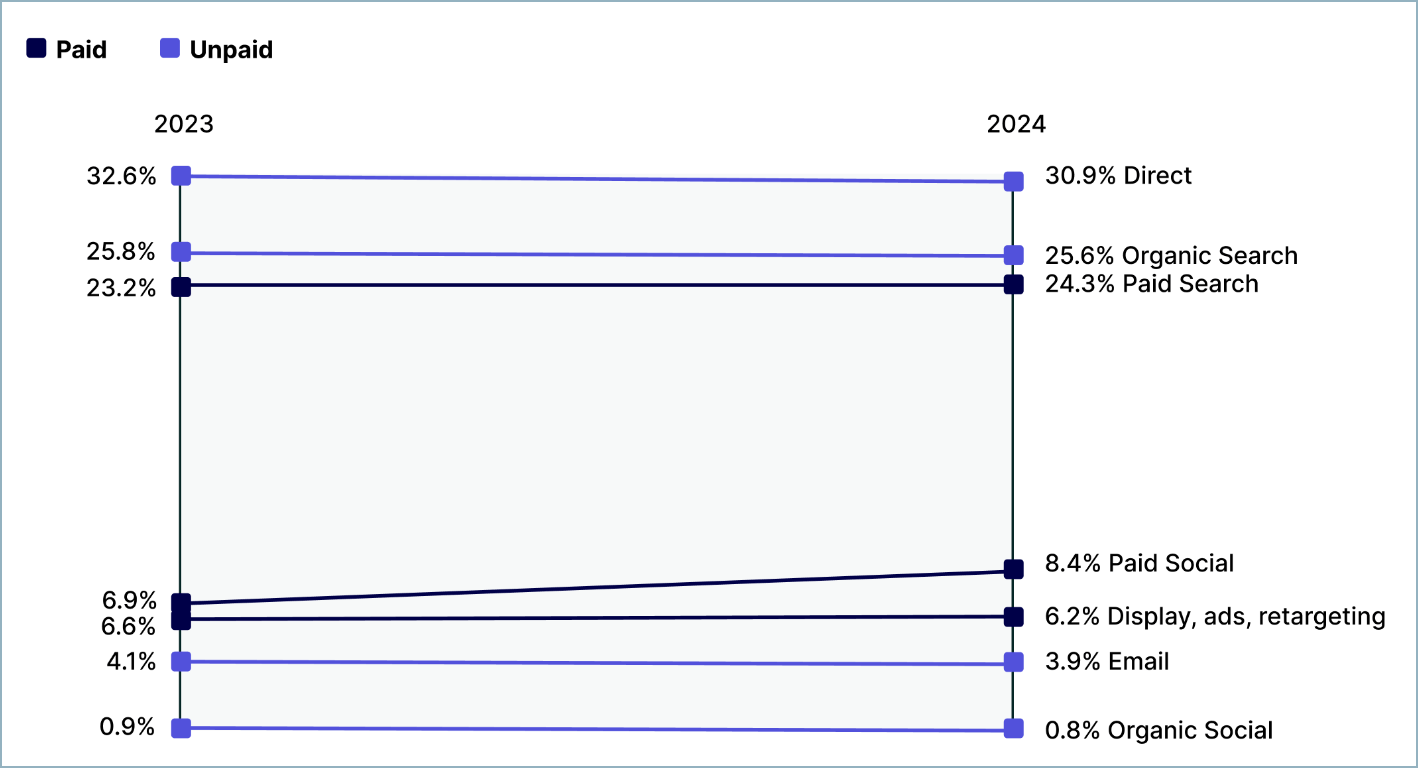
This insight is taken from the 2025 Contentsquare Digital Experience Benchmarks which is a good quality source. Their report is based on website interactions for their 6,000 largest clients using their analytics solution based on a combined 90 billion sessions and 389 billion page views. Their customers are from a range of sectors including Retail, Financial Services, Telecom,Travel & Hospitality, B2B and Public Sector.
Bringing all this together, our definition of digital marketing strategy that is relevant to all businesses from small to large is:
"A plan defining the future direction and investment needed to improve the contribution of digital marketing for a business. It should set SMART objectives for digital channels and prioritize strategic initiatives to harness digital media, data and marketing technology to increase engagement of audiences using digital devices and platforms. Its scope should include opportunities from both new business and revenue models and always-on and campaign communications integrated with offline media and interactions.
As with other types of marketing strategies, an effective digital strategy needs a clear process to define the steps of creating and implementing the plan.
Generative AI (GenAI) tools like ChatGPT and Google Gemini have proved an exciting addition to marketers' toolset. Although it's well known that many marketers are using AI to support copywriting, our research shows that many businesses are using these to support them when creating digital marketing strategies and plans too.
Since GenAI is a key part of modern marketing, we have created many new resources to help marketers tap into them:
Free ChatGPT marketing prompt template Example prompts are structured by the RACE OSA Strategy process. Join Smart Insights as a Free Member to download today Access the ChatGPT prompt examples and cheatsheet for marketers
Did you know many companies don't have a digital marketing strategy?
Our recent Managing Digital marketing research report showed that almost half (47%) of companies don't yet have a planned strategy:
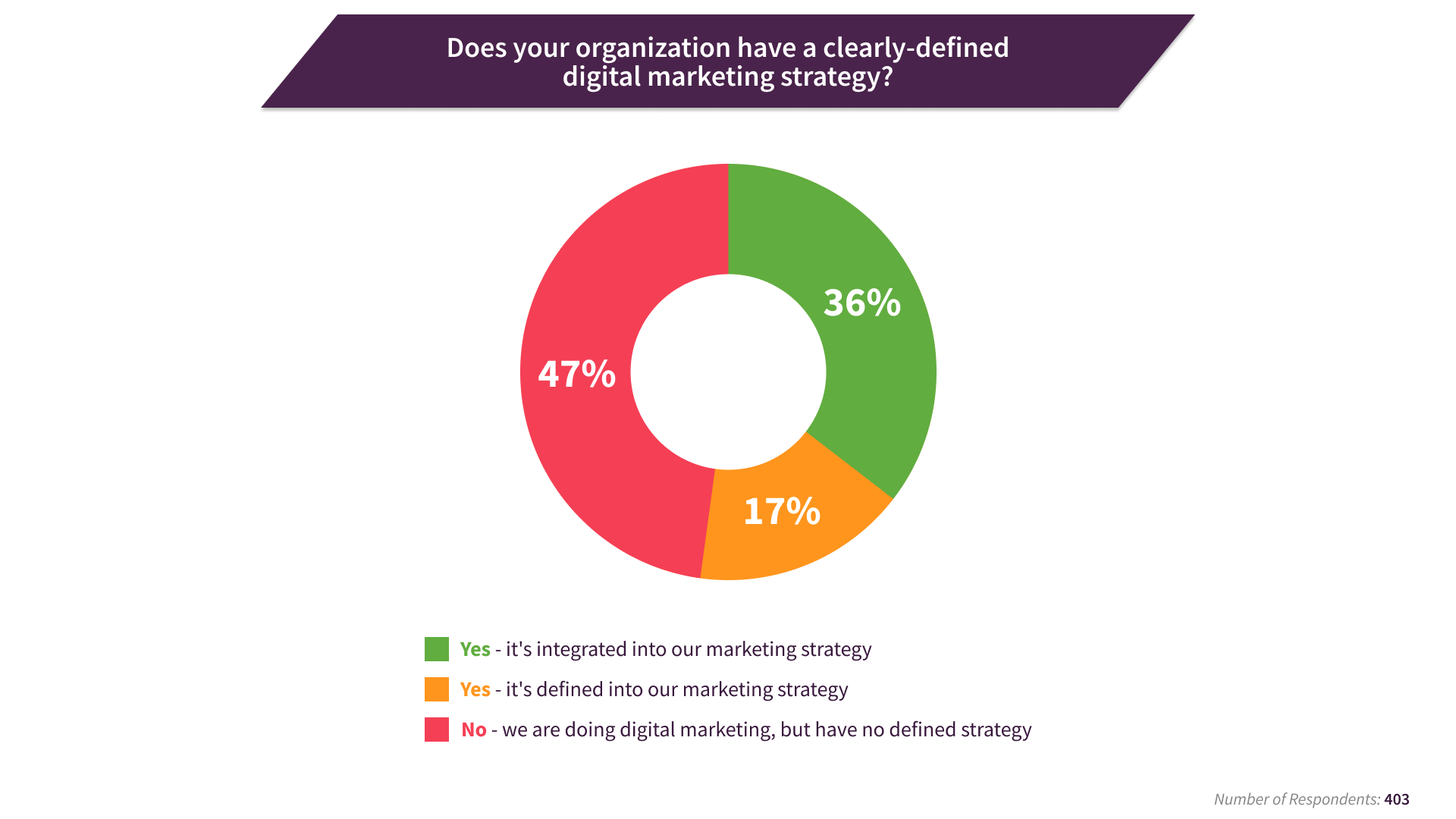
When we launched Smart Insights in 2010, to help marketers develop digital marketing strategies, we saw that many businesses faced the challenge of where to start when creating a digital marketing strategy. The most popular downloads were templates for structuring a digital marketing strategy, and still are.
To help simplify the complexity of digital marketing, we created RACE to provide marketers with a clear structure for creating digital marketing strategies and plans.
Our RACE Growth System for improving marketing effectiveness has two parts to structure your plan that covers both the framework and process that we will introduce in this article using two different visuals:
1. The RACE Planning Framework: defines the essential activities and measures businesses need to master to survive and thrive in today’s marketing world.
2. The RACE OSA improvement process: defines the three steps needed to build and implement your growth plan - either for your overall marketing plan or for an individual channel, such as organic search, social media or email marketing.
If you sign up as a Free member of Smart Insights, you can download our popular 90-day RACE planning template which gives an example of how to use the RACE Growth system for a small business.
Our popular infographic summarizes the 5 steps of the RACE Marketing Planning Framework, which is a classic marketing funnel aimed at improving marketing effectiveness.
The benefit of our digital marketing framework is you can start to see results from your marketing activities instantly, and you can use data and insights to adapt your plan to meet your objectives as you can see below.
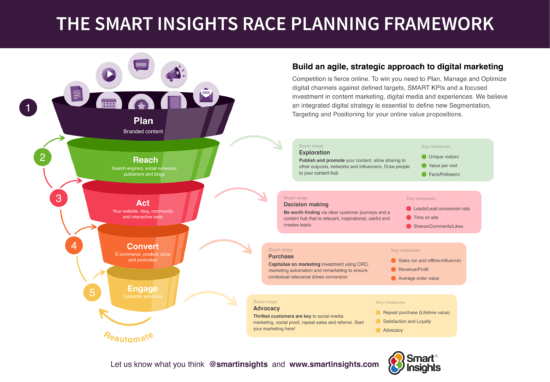
The Smart Insights approach to improving digital marketing maturity is data-driven, so the infographic recommends some of the key measures that should be used to set targets and improve performance at each stage.
Our free planning template recommends what to review to improve results from marketing in more detail.
Free digital marketing plan template Our popular marketing planning template is structured across the Smart Insights RACE Framework. Join Smart Insights as a Free Member to download our digital marketing plan template today Access the Free digital marketing plan template
To make the RACE planning framework actionable, OSA gives a simple process to create your overall strategy and improve the results of individual channels such as search, social media and email marketing.
OSA stands for Opportunity > Strategy > Action
The RACE OSA growth process is designed to help our members improve their results from marketing, customized to their needs based on the size and type of business, their personal experience and needs.
So you can make an instant impact, we recommend you start by creating a 90-day prioritized plan and then create a longer-term annual plan and roadmap.
OSA has three simple parts that integrate with our planning templates, learning paths and other tools:
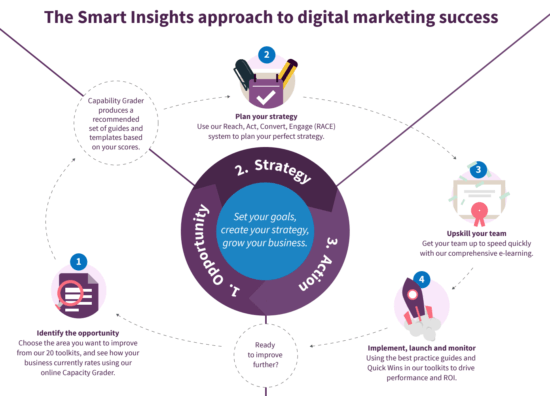
In your first 90-days with Smart Insights, our system will quickly help you decide where you need to prioritize to achieve your business and personal needs by using our learning paths, tools and templates to create your learning and action plan.
What are the key activities in each part of OSA?
You can apply OSA to different marketing activities from creating a growth plan for the next 3 months, creating an annual plan or improving your marketing campaign process. It also works well for driving results from individual channels like the website, organic or paid search, social media or email marketing. You can also apply it to your personal learning and skills development.
Opportunity
Strategy:
Action:
You can then continue improvement using our 90-day planning template.
Every successful digital marketing strategy starts with a plan. We recommend you use a data-driven approach, review your current digital marketing effectiveness, and plan to continuously improve from there using our 90-day planning technique.
A key technique for creating a digital marketing strategy is to ensure that your objectives, marketplace analysis and strategy are well aligned. We use this technique in our templates across RACE to link these three. This works well as a one-page summary of your strategy; we are a big fan of these efficient summaries!
I recommend this example grid layout from our digital marketing plan workbook for aligning your strategies with your objectives, since it provides a simple one to two-page summary of your marketing strategy. Much more effective than a long report your colleagues or clients won't read...
We hope you've found this introduction to digital marketing useful. The remainder of this article gives some additional recommendations for resources on Smart Insights and other websites advising on online marketing strategy.
An effective digital marketing strategy will help you take the right decisions to make a company successful. A strategy process model such as RACE provides a framework that gives a logical sequence to follow to ensure the inclusion of all key activities of strategy development and implementation.
We recommend businesses start by auditing their digital marketing maturity to identify how their current approach may be hampering their ability to compete.
In larger businesses, a strategy will only be successful if it is built on reviewing these 7 core capabilities shown on our maturity assessment:
Free members can download this and other digital channel benchmarks to rate their digital maturity and identify improvements.
Our Digital Transformation Learning Path for Business Professional members shows how to manage the change to provide the right platform for success.
Learn more about the premium membership options for different types of business.
First, a marketing strategy is a proactive, data-driven approach to marketing and communication activity across all channels and touchpoints. The marketing strategy informs all marketing activity taking place for the business since all marketing plans stem from this overarching structure and vision. Once the strategy is set and communicated, marketers use tactics to put into place their actions that drive to the result.
A digital marketing strategy is a channel strategy stemming from a marketing strategy. The digital marketing strategy must...
So put another way, digital marketing strategy defines how companies should:
See our digital marketing statistics sources compilation for recommended statistics on digital adoption, social media, email marketing and conversion rate benchmarks.
There are surprisingly few quality digital marketing strategy sites since most focus on the strategy. We like to think we're different in our focus on strategy too. These are our top sites to learn more about digital marketing strategy:
These are the related techniques which we recommend as important for managing Digital marketing strategy: how to structure a digital marketing plan in 2025 effectively. View these hub pages giving details on best practices, statistics and examples for these techniques:
The Digital Marketing Strategy And Planning toolkit contains:



The Digital Marketing Strategy And Planning toolkit contains:



Start your Digital Marketing Plan today with our Free membership.